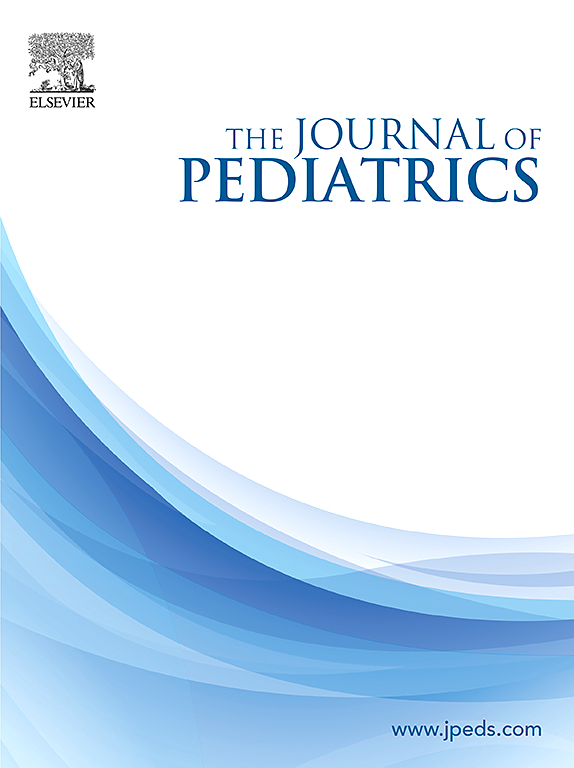Early Vitamin D Supplementation in Infants Born Extremely Preterm and Fed Human Milk: A Randomized Controlled Trial
IF 3.5
2区 医学
Q1 PEDIATRICS
引用次数: 0
Abstract
Objective
To evaluate the effects of vitamin D supplementation on short-term respiratory outcomes in infants born at 28 weeks of gestation or less and fed human milk.
Study design
This masked, randomized controlled trial included infants born extremely preterm and fed human milk in 2023-2024. Infants received either 800 IU/day vitamin D (intervention) or no additional vitamin D (control) for the first 14 days. Masking was maintained by adding 800 IU of vitamin D to daily feedings. The primary outcome was severity of bronchopulmonary dysplasia (BPD) at 36 weeks of postmenstrual age. Secondary outcomes included reactance and resistance (R7-19) measurements, obtained using impulse oscillometry at 36 weeks postmenstrual age, and metabolic bone disease (alkaline phosphatase >500 IU/L and phosphorus <5.5 mg/dL) at postnatal day 28.
Results
A total of 126 infants were randomized (mean birthweight: 759 ± 228 g; 52% female). The intervention increased 25-hydroxy vitamin D3 concentrations (mean difference: +29 ng/mL; P < .0001). The severity of BPD did not differ between groups (P = .60). area under the reactance curve measurements were comparable (674 ± 207 vs 694 ± 240; P = .64) and R7-19 measurements were not significantly lower in the intervention group (23 ± 8 vs 25 ± 9; P = .18). On postnatal day 28, the lower risk of metabolic bone disease observed in the intervention group did not reach statistical significance (9% vs 20%; relative risk: 0.43; 95% CI: 0.16, 1.15; P = .08). No serious adverse events related to the intervention were reported.
Conclusions
Administering 800 IU/day of vitamin D during the first 2 weeks did not reduce BPD severity but may contribute to improved bone health.
Trial registration
ClinicalTrials.gov: NCT05615311. https://clinicaltrials.gov/study/NCT05615311.
早产儿早期补充维生素D和母乳喂养:一项随机对照试验。
目的:评价补充维生素D对妊娠28周及以下母乳喂养婴儿短期呼吸结局的影响。研究设计:这项蒙面随机对照试验包括2023-2024年间极度早产并喂养母乳的婴儿。婴儿在前14天接受800 IU/天的维生素D(干预)或没有额外的维生素D(对照组)。通过在每日饲料中添加800 IU维生素D来维持遮蔽作用。主要终点是经后年龄(PMA) 36周时支气管肺发育不良(BPD)的严重程度。次要结果包括电抗(AX)和阻力(R7-19)测量,在PMA 36周时使用脉冲振荡法获得,代谢性骨病(碱性磷酸酶>500 IU/L和磷)结果:共有126名婴儿随机化(平均出生体重:759±228 g;52%的女性)。干预增加了25-羟基维生素D3浓度(平均差值:+29 ng/mL;干预组p7 -19测量值无显著降低(23±8 vs 25±9;p = 0.18)。在出生后第28天,干预组观察到的代谢性骨病的风险较低,但没有达到统计学意义(9% vs 20%;RR: 0.43;95% ci: 0.16, 1.15;p = 0.08)。没有与干预相关的严重不良事件的报道。结论:在头两周内给予800 IU/天的维生素D并不能降低BPD的严重程度,但可能有助于改善骨骼健康。
本文章由计算机程序翻译,如有差异,请以英文原文为准。
求助全文
约1分钟内获得全文
求助全文
来源期刊

Journal of Pediatrics
医学-小儿科
CiteScore
6.00
自引率
2.00%
发文量
696
审稿时长
31 days
期刊介绍:
The Journal of Pediatrics is an international peer-reviewed journal that advances pediatric research and serves as a practical guide for pediatricians who manage health and diagnose and treat disorders in infants, children, and adolescents. The Journal publishes original work based on standards of excellence and expert review. The Journal seeks to publish high quality original articles that are immediately applicable to practice (basic science, translational research, evidence-based medicine), brief clinical and laboratory case reports, medical progress, expert commentary, grand rounds, insightful editorials, “classic” physical examinations, and novel insights into clinical and academic pediatric medicine related to every aspect of child health. Published monthly since 1932, The Journal of Pediatrics continues to promote the latest developments in pediatric medicine, child health, policy, and advocacy.
Topics covered in The Journal of Pediatrics include, but are not limited to:
General Pediatrics
Pediatric Subspecialties
Adolescent Medicine
Allergy and Immunology
Cardiology
Critical Care Medicine
Developmental-Behavioral Medicine
Endocrinology
Gastroenterology
Hematology-Oncology
Infectious Diseases
Neonatal-Perinatal Medicine
Nephrology
Neurology
Emergency Medicine
Pulmonology
Rheumatology
Genetics
Ethics
Health Service Research
Pediatric Hospitalist Medicine.
 求助内容:
求助内容: 应助结果提醒方式:
应助结果提醒方式:


